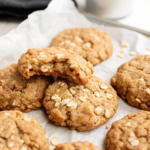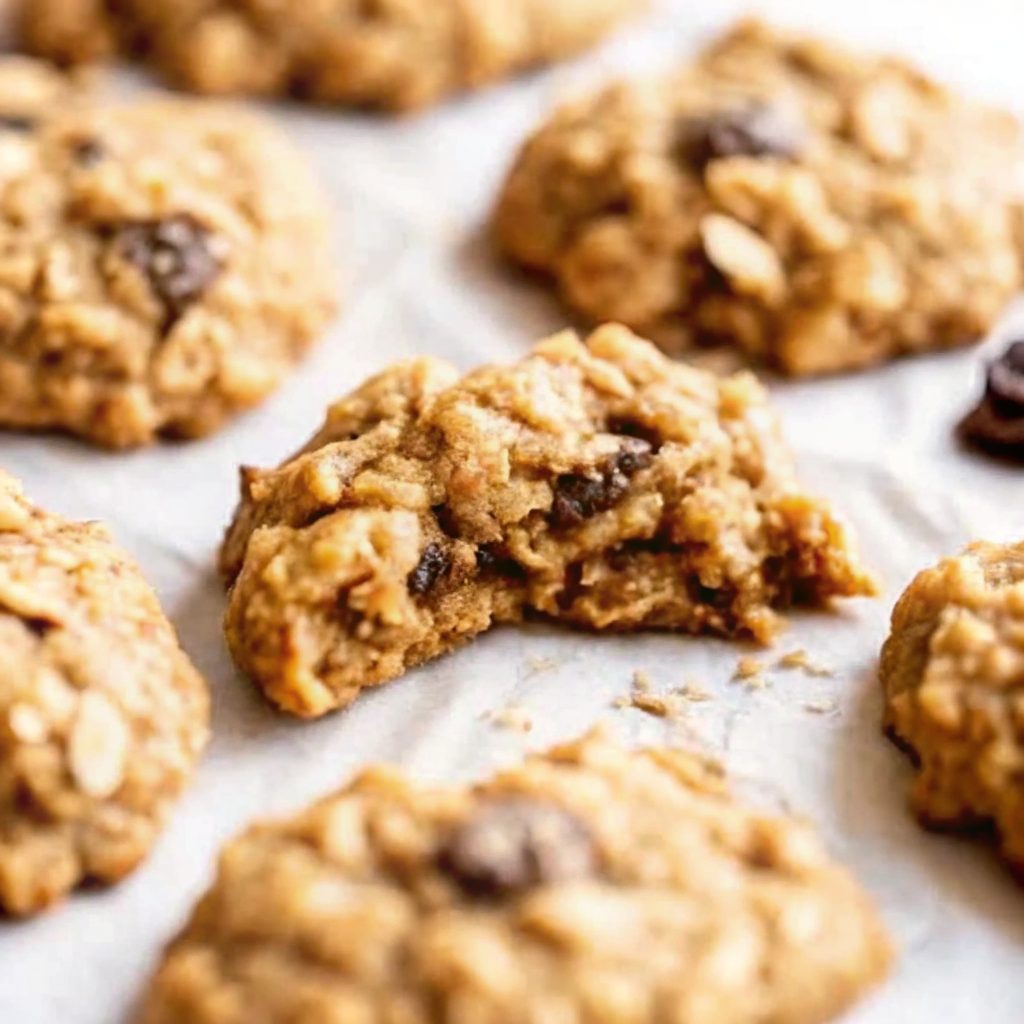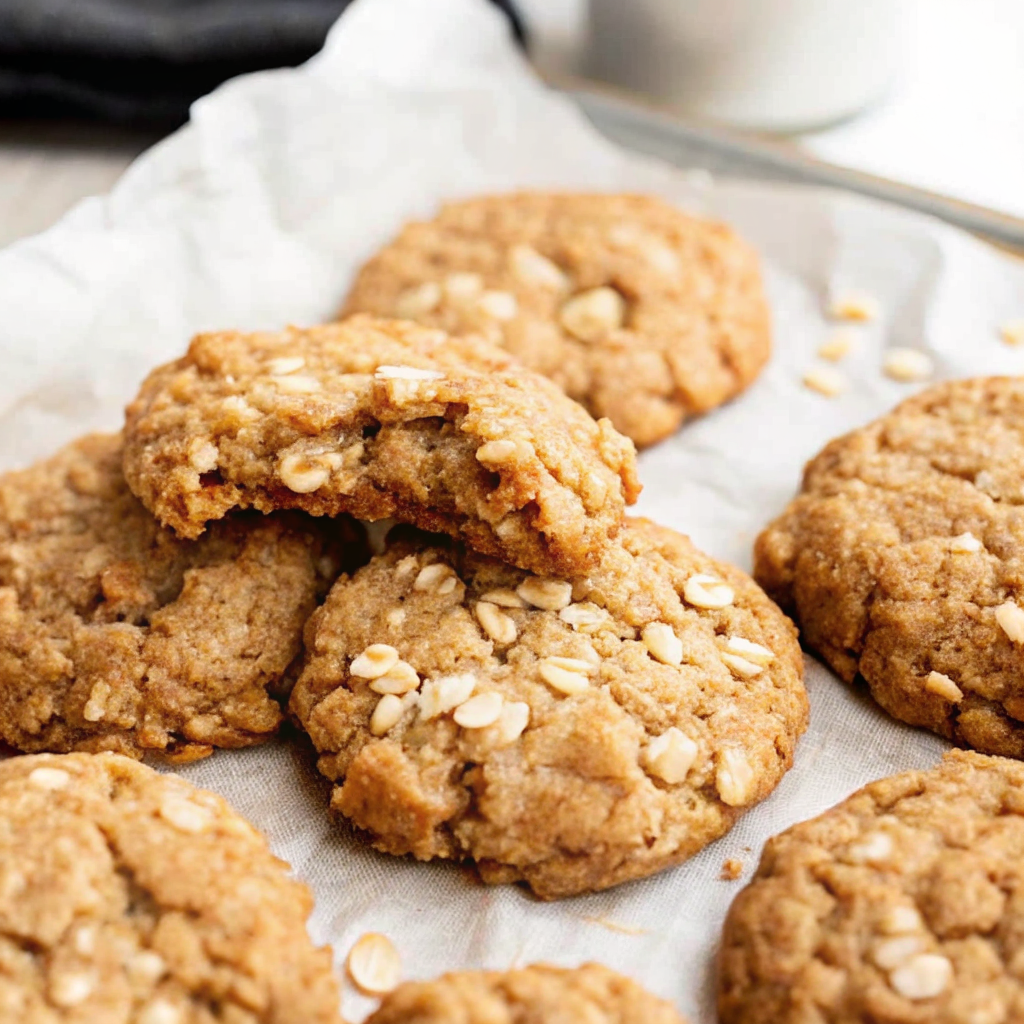If you’re looking for a delightful and unique twist on the classic oatmeal cookie, gluten-free sourdough oatmeal cookies are the way to go. These cookies combine the hearty, chewy texture of oats with the tangy complexity of sourdough discard, creating a treat that’s both flavorful and satisfying. Perfect for those following a gluten-free diet, these gluten-free sourdough oatmeal cookies are a must-try for anyone who loves fresh baked goods with a hint of nostalgia.
In this article, we will walk you through the step-by-step process of making gluten-free sourdough oatmeal cookies, from understanding the essential ingredients to tips for perfecting your baking technique. Let’s dive into how to make the best gluten-free sourdough oatmeal cookies!
Table of Contents
Table of Contents
Introduction to Gluten-Free Sourdough Oatmeal Cookies
The Appeal of Gluten-Free Sourdough Oatmeal Cookies
Gluten-free sourdough oatmeal cookies make it easy to create delicious treats that don’t compromise on flavor or texture. Using sourdough discard in the recipe adds a unique tang, while the oats provide a chewy texture that everyone will enjoy. Plus, since these cookies are made with gluten-free flour, they’re suitable for those with dietary restrictions.
Not only are they easy to make, but the use of sourdough discard helps reduce waste from feeding your sourdough starter. It’s an excellent way to get more use out of ingredients that would otherwise be discarded. And if you’re someone who loves a good chewy cookie with a deep, rich flavor, then these gluten-free sourdough oatmeal cookies are sure to impress.
Why Use Sourdough Discard in Baking?
Many bakers are familiar with the challenge of dealing with leftover sourdough starter, especially when it comes to feeding it regularly. Instead of tossing out the discard, why not use it in your baking? Sourdough discard adds more than just flavor; it brings a subtle tanginess and helps with the texture of the dough.
When used in gluten-free sourdough oatmeal cookies, sourdough discard adds a pleasant chewiness, and the slight sourness perfectly complements the sweetness of the brown sugar and oats. Whether your sourdough discard is fed or unfed, it will work in this recipe, making it a great way to make use of this often-overlooked ingredient.
Print
Gluten-Free Sourdough Oatmeal Cookies
- Total Time: 30 minutes
- Yield: 9–10 cookies 1x
Description
These gluten-free sourdough oatmeal cookies combine the chewy texture of oats with the tangy flavor of sourdough discard, brown butter, and the perfect blend of spices. They’re easy to make and perfect for any gluten-free baking enthusiast.
Ingredients
- 113 grams unsalted butter (which we will brown)
- 10 grams milk powder (optional but recommended)
- 90 grams gluten-free multi-purpose flour (containing xanthan gum)
- ½ teaspoon baking soda
- ½ teaspoon kosher salt
- ½ teaspoon ground cinnamon
- 90 grams brown sugar (light or dark)
- 50 grams granulated sugar
- 70 grams gluten-free sourdough discard (fed or unfed), at room temperature
- 1 large egg yolk, at room temperature
- 1 teaspoon vanilla extract
- 140 grams gluten-free old-fashioned oats
Instructions
- Brown the Butter: Cut the butter into small cubes and melt it in a small saucepan over medium heat. Once melted, add the milk powder (if using) and cook until the butter turns amber and develops a nutty aroma. Let it cool for 15 minutes.
- Prepare the Dough: Whisk together the gluten-free flour, baking soda, cinnamon, and salt. In a separate bowl, mix the sugars and browned butter. Add the egg yolk, vanilla extract, and sourdough discard. Combine all wet ingredients and mix until smooth.
- Combine the Dry and Wet Ingredients: Gently fold the dry ingredients into the wet mixture, then fold in the oats. Chill the dough for 20 minutes.
- Bake the Cookies: Preheat the oven to 350°F (175°C). Portion the dough into 9-10 balls and flatten them into ½-inch thick discs. Bake for 10-11 minutes, until the edges are golden and the centers are slightly soft.
- Cool and Serve: Let the cookies cool on the baking sheet for 5-10 minutes before transferring to a wire rack to cool completely.
Notes
For a richer flavor, add chocolate chips or nuts like walnuts or pecans. Be sure not to overmix the dough to keep the cookies tender and chewy.
- Prep Time: 15 minutes
- Cook Time: 12 minutes
- Category: Dessert
- Method: Baking
- Cuisine: Gluten-Free Baking
Nutrition
- Serving Size: 1 cookie
- Calories: 180
- Sugar: 14g
- Sodium: 85mg
- Fat: 9g
- Saturated Fat: 5g
- Unsaturated Fat: 4g
- Trans Fat: 0g
- Carbohydrates: 25g
- Fiber: 2g
- Protein: 2g
- Cholesterol: 35mg
Essential Ingredients for the Best Gluten-Free Sourdough Oatmeal Cookies
Understanding Gluten-Free Multi-Purpose Flour
When it comes to baking gluten-free sourdough oatmeal cookies, choosing the right flour is crucial for achieving the perfect texture. For this recipe, we recommend using gluten-free multi-purpose flour that contains xanthan gum. Xanthan gum is a natural thickening agent that helps mimic the elasticity of gluten, ensuring your cookies hold their shape and aren’t crumbly.
If you don’t have xanthan gum in your flour, you can add it separately (about ½ teaspoon). This is especially important in gluten-free baking, as xanthan gum helps improve the texture and consistency of your dough, making it easier to work with.
The Role of Brown Butter in Your Cookie Recipe
One of the standout ingredients in this recipe is brown butter. The process of browning butter adds a rich, nutty flavor that elevates your gluten-free sourdough oatmeal cookies to the next level. As the butter heats up, the milk solids caramelize, creating a depth of flavor that adds sophistication to your cookies.
Brown butter is a simple yet effective way to make your gluten-free sourdough oatmeal cookies taste extraordinary. The nutty aroma that fills your kitchen as the butter browns is enough to make anyone’s mouth water. It’s a must for this recipe!
Why Use Oats in Gluten-Free Sourdough Oatmeal Cookies?
Oats are the perfect addition to gluten-free sourdough oatmeal cookies. Not only do they provide texture and chewiness, but they also enhance the flavor of your cookies. Be sure to use gluten-free old-fashioned oats to keep the recipe fully gluten-free. While oats are naturally gluten-free, they can sometimes be cross-contaminated with gluten if processed in facilities that handle wheat products. Look for oats that are specifically labeled gluten-free to be safe.
Oats add a hearty, satisfying element to the cookies, making each bite feel more substantial. They’re also great for creating that traditional oatmeal cookie texture, which pairs wonderfully with the tang of the sourdough discard.
How to Make Brown Butter for Gluten-Free Sourdough Oatmeal Cookies
Step-by-Step Process for Browning Butter
Browning butter may seem intimidating at first, but it’s an easy process that adds incredible flavor to your gluten-free sourdough oatmeal cookies. Here’s how to do it:
- Cut the butter into small cubes and place it in a small saucepan over medium heat.
- Let the butter melt completely, stirring occasionally to ensure it doesn’t burn.
- Add the milk powder (if using) once the butter has melted. Stir to combine. The milk powder will cause the butter to foam, so keep stirring to avoid burning.
- Continue to cook the butter for several minutes until it turns a medium amber color and develops a nutty aroma. Be cautious, as it can burn quickly at this stage.
- Once browned, remove the butter from the heat and transfer it into a heat-proof bowl, making sure to include all the brown bits at the bottom of the pan. Allow the butter to cool for about 15 minutes before continuing with your cookie dough.

Preparing the Cookie Dough: Mixing the Wet and Dry Ingredients
Whisking Together the Dry Ingredients
To start, you’ll need to whisk together your dry ingredients in a separate bowl. This includes the gluten-free flour, baking soda, cinnamon, and kosher salt. Whisk them until they are well combined, ensuring that there are no lumps in the flour. It’s important to mix your dry ingredients first to ensure an even distribution of the baking soda and cinnamon, which helps with both texture and flavor in the final cookies.
Make sure the flour you use has xanthan gum included to help with structure, or add it separately if your flour blend does not contain it. This will give your cookies the proper texture and prevent them from crumbling.
For more recipes Facebook and Pinterest
How to Incorporate the Wet Ingredients Without Overmixing
Next, in a separate bowl, add the cooled brown butter, brown sugar, and granulated sugar. Whisk these together until smooth and fully incorporated. The sugar should dissolve into the butter, creating a silky mixture. Then, add the room-temperature egg yolk, vanilla extract, and sourdough discard into the wet mixture, whisking until the ingredients are fully combined and slightly thickened.
It’s important to not overmix at this stage. Overmixing can lead to dense cookies, which you definitely want to avoid. Once the wet ingredients are smooth and slightly thickened, it’s time to gently fold in your dry ingredients.
The Importance of Chilling Your Cookie Dough
After folding in the dry ingredients, you’ll notice that the dough may be a bit sticky. This is perfectly normal, especially with gluten-free dough. To help set the dough and ensure the cookies hold their shape during baking, you should chill the dough in the fridge for at least 20 minutes. Chilling the dough allows the butter to firm up and the flour and oats to properly hydrate. This will also help the cookies spread less during baking, leading to a thicker, chewier cookie.
The Best Gluten-Free Flour Options for Sourdough Oatmeal Cookies
Gluten-Free Multi-Purpose Flour vs. Other Gluten-Free Flours
When it comes to baking gluten-free cookies, the flour you choose will make a huge difference in the final texture and taste. Gluten-free multi-purpose flour is the best option for this recipe as it mimics regular flour closely and gives you a soft, chewy texture. However, if you’re looking for alternatives, there are a few other gluten-free flours you can experiment with:
- Rice flour: Often used as a base in gluten-free baking, it creates a lighter texture.
- Almond flour: Adds richness and a nutty flavor but can make cookies more delicate.
- Tapioca or potato flour: These can help add chewiness but need to be combined with other flours for the best result.
The key to a good gluten-free cookie is ensuring you balance your flours so that the texture doesn’t become too dense or dry. Using a pre-blended gluten-free flour that includes xanthan gum (like in this recipe) helps maintain structure.
Choosing the Right Flour for Moist Cookies
For moist, chewy cookies, opt for a gluten-free multi-purpose flour blend that contains a mix of flours such as rice flour, tapioca starch, and potato starch. These flours absorb moisture and retain it during baking, helping the cookies stay soft and tender. Another important factor for moisture retention is the addition of brown butter, which also helps keep the cookies moist.
For those sensitive to the texture of gluten-free flours, experimenting with a combination of almond flour or coconut flour can add a unique flavor and texture to your cookies as well. But keep in mind, too much of these flours can make the dough a little drier.
Adding Xanthan Gum for Structure
One of the key ingredients to ensure your gluten-free sourdough oatmeal cookies have the right texture is xanthan gum. This ingredient helps give the dough structure and elasticity, similar to what gluten does in traditional baking. Most gluten-free flour blends include xanthan gum, but if you’re using a single flour type like rice flour or almond flour, you’ll need to add it separately (usually about ½ teaspoon).
Baking and Shaping the Perfect Gluten-Free Sourdough Oatmeal Cookies
Oven Temperature and Cookie Spacing Tips
Now that your dough is chilled and ready to bake, it’s time to preheat your oven to 350°F (175°C). It’s essential to position your oven racks in the middle of the oven for even heat distribution. Place a parchment paper-lined baking sheet on the rack for easy cookie removal and to prevent sticking.
When portioning out your cookie dough, use a 2-tablespoon cookie scoop to create uniform-sized dough balls. This ensures that your cookies bake evenly. You should aim to place about 6 cookies per baking sheet, as they will spread slightly during baking.
How to Shape Your Cookies for Uniformity
Once you’ve portioned out the dough, gently flatten each dough ball into a ½-inch thick disc. This will help your cookies bake evenly and prevent them from turning out too thick. Flattening the dough balls also promotes an even spread during baking, so they will look uniform and appealing.
If you like your cookies with crisp edges, feel free to flatten them a little more. For chewier cookies, a slight mound in the center of the dough ball will result in a thicker cookie that stays soft and chewy.
Tips for Achieving Soft, Chewy Cookies
To ensure your cookies remain soft and chewy, don’t overbake them. Bake your cookies for 10-11 minutes until the edges are golden, and the center is still slightly soft. Remove them from the oven and use a round cookie cutter or glass to gently shape the cookies into perfect rounds while they are still warm.
This step helps give the cookies a uniform, round shape and also evens out any slight spread that occurred during baking. Let the cookies cool on the baking sheet for 5-10 minutes before transferring them to a wire rack to cool completely.
(FAQs) About Gluten-Free Sourdough Oatmeal Cookies
What Flour is Best for Gluten-Free Sourdough?
The best flour for gluten-free sourdough cookies is a gluten-free multi-purpose flour blend. This flour is formulated to mimic the properties of wheat flour, making it ideal for creating cookies with a similar texture to traditional ones. Look for a flour blend that includes xanthan gum, which helps provide structure and elasticity. You can also experiment with adding individual gluten-free flours like rice flour or almond flour, but multi-purpose blends typically offer the best results for texture and flavor.
What is the Best Gluten-Free Flour for Moist Cookies?
For moist gluten-free cookies, use a multi-purpose gluten-free flour that includes a mix of flours such as rice flour, tapioca flour, and potato starch. These flours retain moisture and contribute to the chewy texture you want in a cookie. Adding brown butter to your dough also helps keep the cookies moist, as the fat in the butter retains moisture better than other oils or fats.
Can I Add Oatmeal to Sourdough?
Yes! Oats are a great addition to sourdough recipes, including gluten-free sourdough oatmeal cookies. Oats not only provide a chewy texture but also add flavor and heartiness to your cookies. Just be sure to use gluten-free oats if you are strictly gluten-free, as oats can sometimes be cross-contaminated with wheat. Using old-fashioned rolled oats gives the best texture, adding a satisfying chew to every bite.
What Can I Substitute for Flour in Oatmeal Cookies?
If you’re looking to substitute flour in oatmeal cookies, there are several options. For a gluten-free version, you can substitute gluten-free flour blends or almond flour. Coconut flour is another option but tends to absorb a lot of moisture, so you’ll need to adjust the wet ingredients. Oat flour (which is made by grinding oats into flour) is another great option for oatmeal cookies, adding a lovely oat flavor and texture. If you’re not concerned about gluten, you can also use whole wheat flour for a slightly nuttier flavor.
